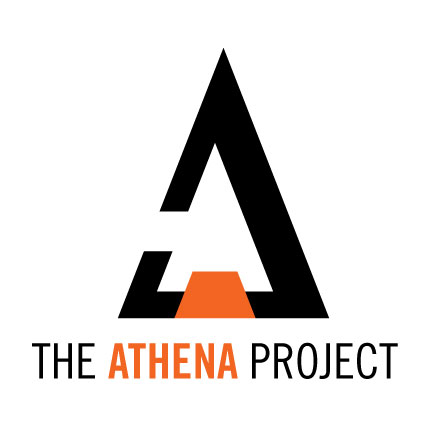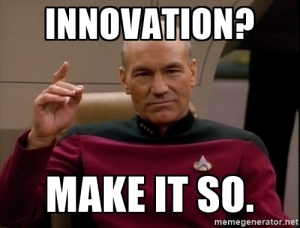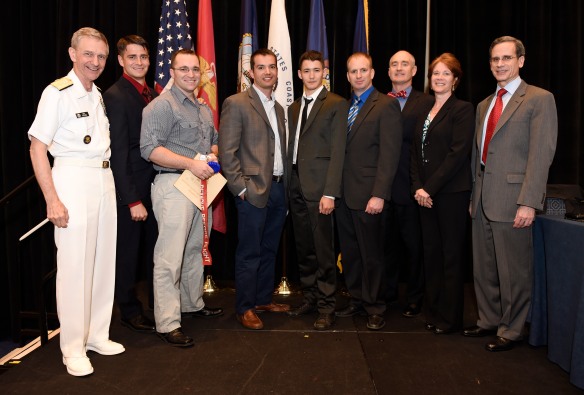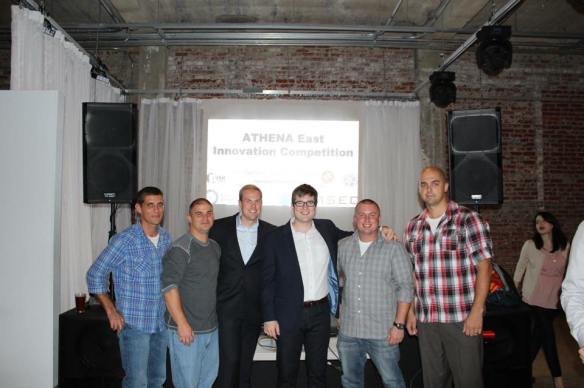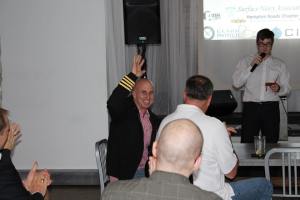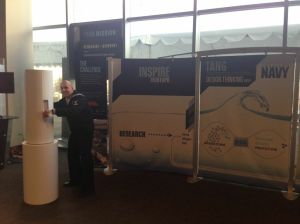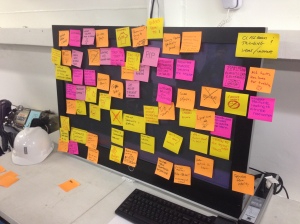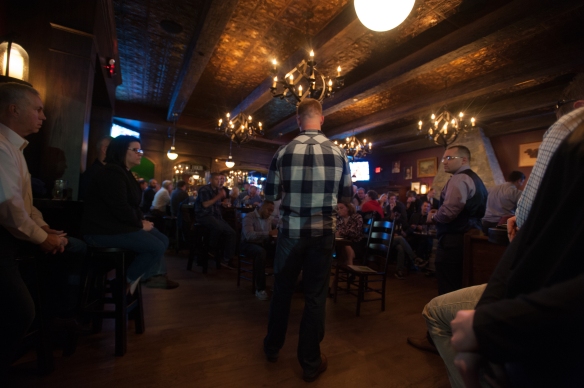
By AT1 Mike Pecota
Following last year’s inaugural Athena DC 1.0, the second event had much to live up to. In contrast to the previous year’s grand setting inside the Gaylord National Convention Center this year’s event took place in a much more traditional Athena setting: The Irish Whisper Pub right in the heart of National Harbor and it didn’t take long for the audience of Athenians to take over the entire space!
Both years’ events immediately followed the Sea Air Space convention held annually at the Gaylord, taking advantage of the senior Naval leadership the convention brings with it each year.
After winning last year’s event, I had the distinct honor of hosting this year’s event (and being the first Enlisted host of any Athena event). We kicked off with a brief introduction and welcome, we began to foster in a new generation of innovative thinkers!
In keeping up with the high standards set in DC 1.0, this years panel members were hand-chosen for their contribution to innovation leadership in the local area. Unlike any event before it, this year’s presenters and board members alike represented the best of innovation from both the Navy and Marine Corps. Board members included Joshua Smith, the director of TANG at Johns Hopkins Applied Physics Lab; Monica Hutchins, a leader within the Strategy and Innovation office at the Deputy Under Secretary of the Navy (Management); and Captain James Lamontie of the Marine Corps’ Installation and Logistics (I&L) office and the NexLog Innovation Cell.
The years of experience in grassroots innovation these panelists brought to the table made for some impactful insights into our presenters’ pitches!
And without further ado, let’s get to the ideas!

Sims Winner Jerin Raby, and the host (and his 3D Printed bowtie).
AM2 Jerin Raby – Fleet Readiness Center Mid Atlantic, Detachment Patuxent River
*** Athena DC 2.0 Admiral Sims Award for Intellectual Courage ***
Jerin presented her idea, which comes right from the “why aren’t we already doing this” file, with the clarity and expertise of an experienced Sailor well versed in the difficulties facing all aviation maintenance. Her proposal – to replace the oversized metallic toolboxes, used throughout Naval flight line maintenance, with lighter custom made backpacks – clearly struck the heartstrings of the crowd. As she reflected on her past experiences with the cumbersome toolboxes, you could see the expressions of many in the room as they recanted their own trials and difficulties using the outdated boxes.
The main focus of Jerin’s proposal was to help eliminate back problems and related injuries associated with lugging the tool boxes across flightiness and up and down ships’ ladderways. She explained the safety concerns and dangers the boxes pose to others as one makes their way through dark hallways. A secondary focus of her proposal was the benefits sailors having the use of both hands on the flight line and while traversing ships. Any maintainer could now have the use of both hands to keep them on their feet while traveling around the ship.
HM2 Joshua Cranford – Naval Hospital Annapolis
Joshua returned to the ATHENA DC, making him the only presenter to pitch ideas at both settings. As a reflection of his idea last year to increase mission readiness and cost savings by switching duty vehicles over to hydrogen power, this year he proposed taking the eco friendly hydrogen power and introducing it to the world of submariners. The extreme dedication to his mission, of a Navy powered by hydrogen power, shone as he walked the crowd through the pro’s and cons of having this alternative fuel powering the vessels of tomorrow.

One of the crowd voters, and his soon-to-be-scored presentation grading sheet.
AE3 Jordan Brady – Fleet Readiness Center Mid Atlantic, Detachment Washington
Jordan knew after witnessing ATHENA DC 1.0 first hand, that he was going to bring an idea in 2017. His concept was to use high powered lasers to aid sailors in the tedious task of corrosion removal. With corrosion being the number one enemy of any metal floating in the middle of the ocean, his idea spoke to both the surface and aviation members of the audience. Many of whom have undoubtedly spent many painstaking hours with needle guns and wire brushes keeping their vessels in the fight whether on the sea or in the air.
SSgt Alex Long – Ammunition Logistics Focus Team
Alex was the first Marine ever to bring an idea to an Athena event! His time working with munitions and weapons lead him to the startling discovery that humans are flawed. One individual manning a armory can hold up the operations of an entire unit. Alex’s solution was to automate the system through the use of robotics and digital accountability. His idea is not new to the logistics, but hasn’t found it’s rightful place in the world of weaponry in the Marine Corps, according to Alex.
AOAN Marissa Cross – Fleet Readiness Center Mid Atlantic, Detachment Patuxent River
Marissa finished the evening with a lifesaving bit of innovation. Her take on shipboard safety assisted any personal facing catastrophic conditions while potentially trapped within a ship. The problem: during true crisis at sea, vision is usually impaired making the glow-in-the-dark stickers (telling one their location in the ship) virtually unusable. Her solution: place 3D printed arrows throughout the ship directing sailors to the nearest point of exit. This allowed anyone who may find themselves visually impaired to tactually find their way to safety regardless of visibility.
In reflection, the authenticity of the evening’s setting combined with the passion of the presenters made for a night of true innovation. The ideas exchanged and connections made instilled an exhilarating air of electricity much needed in todays ever evolving military. The integration of two branches with the common goal of mission readiness will help set the pace for all future endeavors both here in the great United State of America, and abroad to wherever the mission may take us next.
AT1 Mike Pecota is an Aviation Electronics Technician /Assistant Innovation Team Lead for Fleet Readiness Center Mid Atlantic, Detachment Patuxent River. He’s also a driving force on the Additive Manufacturing Team and Innovation Cell at NAVAIR and the Admiral Sims Award winner from Athena DC 1.0.

